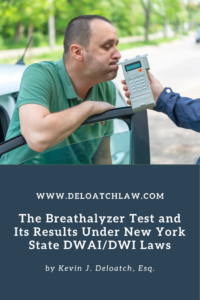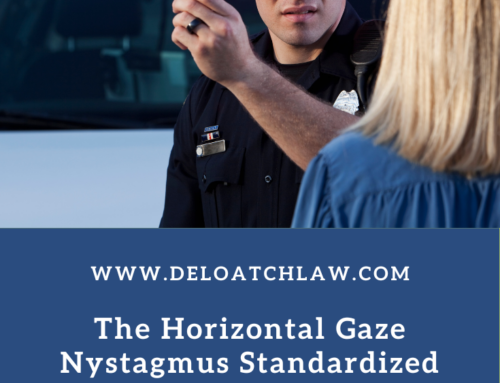Have you been arrested for driving under the influence (DUI) in New York state and asked to take a breathalyzer test? What is a breathalyzer test and what is the effect of its results on your case? Should you refuse to take the breathalyzer test?
Being arrested and charged with DUI is an extremely stressful situation for most people. There will be a number of questions going through a person’s head when they find themselves in this situation. If you are unfortunate enough to find yourself in this position, you will be subjected to a battery of standardized field sobriety tests, including a breathalyzer test. New York is an implied consent state, meaning that anyone stopped for suspected DUI is implied to have consented to taking the battery of field sobriety tests.
Depending on the facts and circumstances of your arrest and your driving history, a conviction could mean anything from a loss of driving privileges to a substantial term of imprisonment. It can also be the difference between a violation, misdemeanor or a felony conviction. Moreover, since New York is an implied consent state, if you refuse to take the field sobriety tests, including the breathalyzer, your “refusal” will be used in the criminal case against you as an admission (i.e., you admitting to being under the influence). Your “refusal” will also subject you to additional penalties from the Department of Motor Vehicles (DMV), including having your driving privileges revoked. Thus, in New York State it is not a good idea to refuse to take field sobriety tests.
So, what exactly is a breathalyzer test, and what role do the results play in a DUI prosecution in New York state?
The Breathalyzer Test
 The breathalyzer is a standardized chemical test that law enforcement uses to determine if someone is under the influence and/or over the “legal limit” for the consumption of alcohol. Unlike some of the other standardized tests regarding DUIs, it is a chemical test that is used to determine the amount of alcohol “in a person’s system” (i.e., in their blood after being consumed and metabolized). The breathalyzer has been validated through extensive research sponsored by the National Highway Traffic Safety Administration (NHTSA) and has been found to be a reliable test, provided it is administered in accordance with specific standardized procedures.
The breathalyzer is a standardized chemical test that law enforcement uses to determine if someone is under the influence and/or over the “legal limit” for the consumption of alcohol. Unlike some of the other standardized tests regarding DUIs, it is a chemical test that is used to determine the amount of alcohol “in a person’s system” (i.e., in their blood after being consumed and metabolized). The breathalyzer has been validated through extensive research sponsored by the National Highway Traffic Safety Administration (NHTSA) and has been found to be a reliable test, provided it is administered in accordance with specific standardized procedures.
In New York, DUIs are referred to as driving while ability impaired (DWAI) and driving while intoxicated (DWI). New York’s DWAI and DWI laws are covered under Vehicle and Traffic Law (VTL) § 1192 (e.g., Operating a motor vehicle while under the influence of alcohol or drugs), and its various subsections. Specifically, for the holders of a non-commercial driver’s license and drivers over the age of 21, DWAI is covered under VTL § 1192(1), while DWI is covered under VTL § 1192(2) and VTL § 1192(3). Under both VTL § 1192(2) and VTL § 1192(3), the prosecution must prove that the person had a blood/breath alcohol concentration (e.g., BAC/BrAC) of .08 or greater.
In many jurisdictions, including New York state, the results/conclusions of the breathalyzer test are only admissible as evidence of someone being under the influence, and/or over the legal limit of alcohol consumption, if the prosecution can provide a proper foundation for the reliability of the test results. Thus, before the prosecution can introduce the results into evidence in the criminal case against you, it has the burden of proving, in addition to other things, that the test was both: 1) properly performed; and 2) by someone who was properly trained to administer the test.
Under New York law, the department of health has established rules and regulations governing the techniques and methods to be used in conducting the chemical analyses of a person’s blood, urine, breath or saliva. These rules and regulations necessarily include machines used in breathalyzer testing.
The standardized nature of the breathalyzer test is the cornerstone to the reliability of the test’s results. Thus, the test must be administered in accordance with the specific standardized procedures for the results to be reliable. If not, the results of the test are inadmissible as evidence by the prosecution. Indeed, in a notable case, People v. Hillman, 2019 NY Slip Op 51555 – NY: City Court 2019, the court determined:
[T]he results of the field sobriety tests are inadmissible because the People have failed to prove that they had been administered in a manner consistent with the “Concepts and Principles of the Standardized Field Sobriety Tests” manual promulgated by the National Highway Traffic Safety Administration (NHTSA). Therefore, the Court cannot rely on the field sobriety tests, thereby stripping the test results of any probative value.
So, the big question is: what are the NHTSA standardized “Concepts and Principles” regarding the breathalyzer test?
Anatomy of the Breathalyzer Test
In short, the breathalyzer is a chemical test that measures the amount of alcohol that has been metabolized and is in a person’s blood. It does this by detecting the presence of a specific chemical in a person’s breath after alcohol has been consumed and metabolized. The presence of this chemical is then measured and given a numeric expression, describing its presence in parts per million in relation to the person’s blood (i.e., BAC – blood alcohol concentration and BrAC – breath alcohol concentration). In New York, the legal limit of alcohol, for purposes of proving intoxication is a BAC/BrAC of .08 or greater.
The breathalyzer test is administered with a machine that measures and analyzes a subject’s breath sample. The test is administered by having the subject blow a breath sample in the breathalyzer machine, where the breath sample is then analyzed.
There are various makes/models of machines that can perform the analysis. However, and as previously discussed, the Department of Health in New York has established rules and regulations governing the chemical analyses of a person’s blood, urine, breath, or saliva. Thus, any machine used for such purposes in New York state must be approved by the Department of Health and operated in accordance with the proper procedures.
Law enforcement is advised that there are various factors that should be taken into consideration when administering the breathalyzer test, as such factors can negatively impact the test results. Accordingly, under New York law, there are specific procedures that must be adhered to when the test is administered. Specifically, under the Official Compilation of Codes, Rules, and Regulations of the State of New York, 10 NYCRR §59.5(b):
The following breath analysis techniques and methods shall be a component of breath analysis instrument operator training provided by training agencies and shall be used by operators performing breath analysis for evidentiary purposes:
(b) the subject shall be observed for at least 15 minutes prior to the collection of the breath sample, during which period the subject must not have ingested alcoholic beverages or other fluids, regurgitated, vomited, eaten, or smoked, or have placed anything in his/her mouth: if the subject should regurgitate, vomit smoke or place anything in his/her mouth, an additional 15-minute waiting period shall be required.
Thus, law enforcement must ensure that the subject did not have anything in their mouth for at least 15 minutes prior to the test being administered, otherwise the results may be determined to be inadmissible.
Thorough Preparation
In New York state, the administration of chemical tests to determine BAC/BrAC, like the breathalyzer, are recorded on video. Reviewing all the discovery in the case file is always important. However, very few things reveal the strengths and weakness of a case like a clear video of what transpired. This is particularly true when dealing with the administration of standardized chemical tests such as the breathalyzer. Video is one of many ways of determining whether the breathalyzer test was properly administered. In my personal experience, it has led to many successful resolutions of DWAI/DWI cases by serving as the bases for motions rendering the test results inadmissible.
Hiring a Criminal Defense Attorney
So, have you been arrested for driving under the influence (DUI) in New York state and asked to take a breathalyzer test?
Navigating the criminal justice system is difficult and has serious consequences. Hiring a criminal defense attorney is one of the single most important decisions you will make in your life. Make sure you hire an attorney that takes time to understand you as a person and your case in its entirety. The breathalyzer test is just one of many standardized field sobriety tests that will be administered if you are stopped for DUI in New York State.
At the Law Office of Kevin J. Deloatch, Esq., each case is handled from the initial stage with trial in mind. This enables me to not only understand the strengths of the defense, but more importantly, to effectively convey to the prosecutor the weaknesses of their case.
If you or someone you know has been charged with a crime in New York call the Law Office of Kevin J. Deloatch, Esq. at (646) 792-2156. The results of all criminal prosecutions are determined by the facts and circumstances of your specific case and the skill and experience of your defense attorney. Call today for a free consultation.








